 Before this mall on the South Side was La Gran Plaza it was Town Center. Before it was Town Center it was Seminary South. And before it was Seminary South it was Katy Lake.
Before this mall on the South Side was La Gran Plaza it was Town Center. Before it was Town Center it was Seminary South. And before it was Seminary South it was Katy Lake.
 As this Fort Worth Telegram news story from July 30, 1907 indicates, on that date the Katy (Missouri-Kansas-Texas) railroad announced that it would build a “large storage lake” in the south part of town to supply water for its steam engines. The lake began supplying water in 1908.
As this Fort Worth Telegram news story from July 30, 1907 indicates, on that date the Katy (Missouri-Kansas-Texas) railroad announced that it would build a “large storage lake” in the south part of town to supply water for its steam engines. The lake began supplying water in 1908.
 This 1903 map shows how extensive the Katy line was in Texas. There were even other Katy Lakes along the railroad line, for example, near Hillsboro, Waco, Georgetown, and Waxahachie. Waxahachie’s Katy Lake still exists. (The town of Katy, Texas also was named for the railroad.)
This 1903 map shows how extensive the Katy line was in Texas. There were even other Katy Lakes along the railroad line, for example, near Hillsboro, Waco, Georgetown, and Waxahachie. Waxahachie’s Katy Lake still exists. (The town of Katy, Texas also was named for the railroad.)
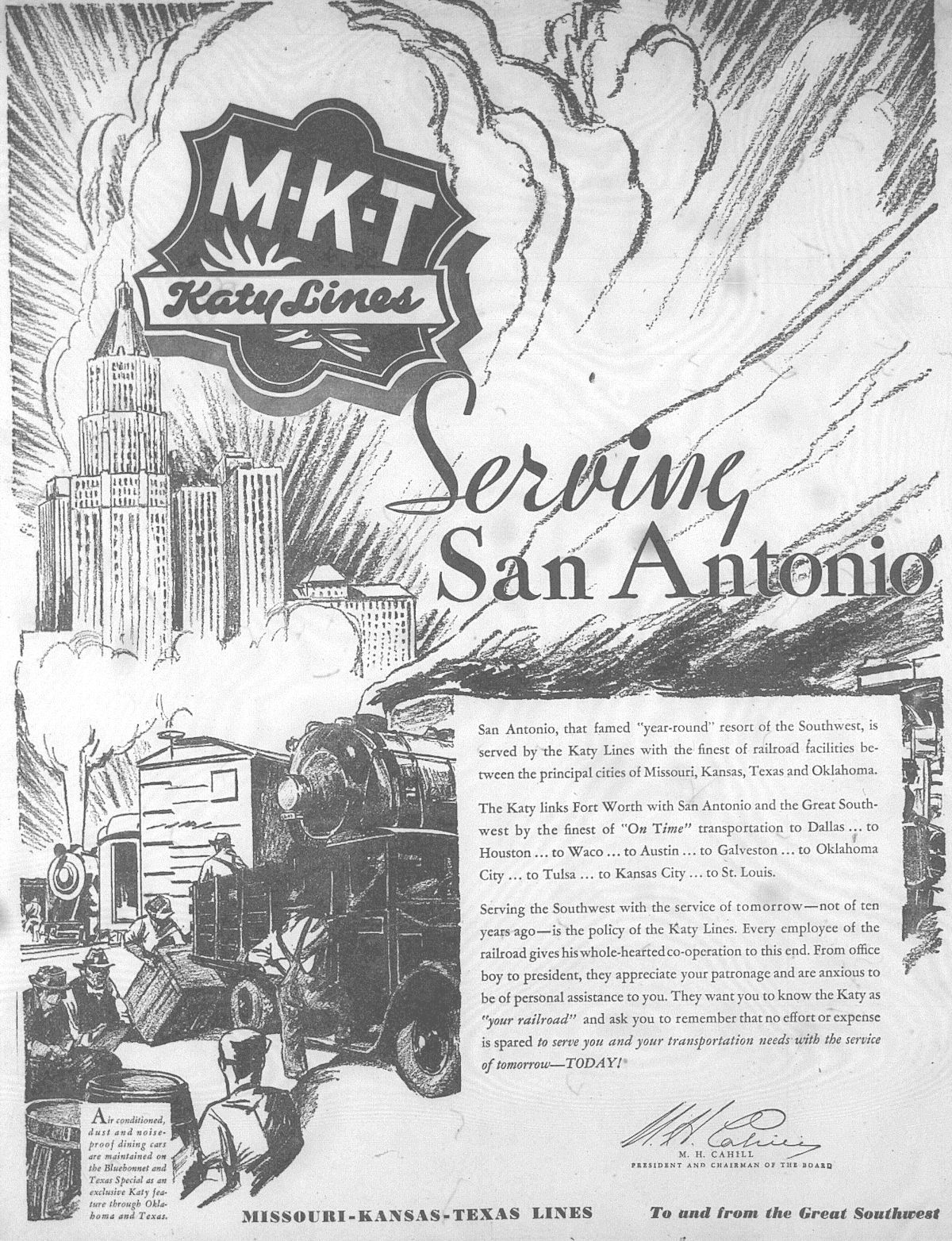 The Katy line was a major railroad for Fort Worth for a half-century. This ad is from a 1933 Fort Worth Press.
The Katy line was a major railroad for Fort Worth for a half-century. This ad is from a 1933 Fort Worth Press.
 The railroad may have impounded Katy Lake for purely practical reasons, but the little lake soon became popular with anglers. This fishing roundup in the May 21, 1919 Star-Telegram mentions two railroad lakes in south Fort Worth: Katy Lake and International & Great Northern railroad’s lake (Echo Lake), built in 1903. (Lake Como was impounded in 1890 for the Arlington Heights trolley park and streetcar line.)
The railroad may have impounded Katy Lake for purely practical reasons, but the little lake soon became popular with anglers. This fishing roundup in the May 21, 1919 Star-Telegram mentions two railroad lakes in south Fort Worth: Katy Lake and International & Great Northern railroad’s lake (Echo Lake), built in 1903. (Lake Como was impounded in 1890 for the Arlington Heights trolley park and streetcar line.)
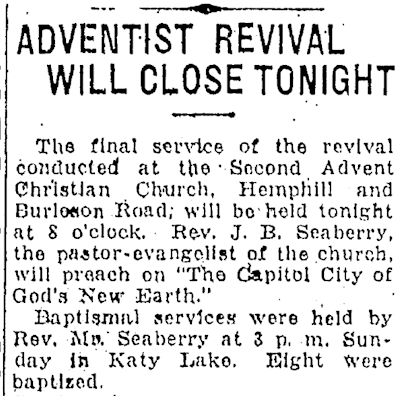 The Katy railroad lake also became popular as a recreation area: People fished there, hunted ducks there. Churches held hayrides and baptisms there. During World War I aviation cadets of Barron Field in Everman, one of the three airfields of the Army’s Camp Taliaferro, swam there.
The Katy railroad lake also became popular as a recreation area: People fished there, hunted ducks there. Churches held hayrides and baptisms there. During World War I aviation cadets of Barron Field in Everman, one of the three airfields of the Army’s Camp Taliaferro, swam there.
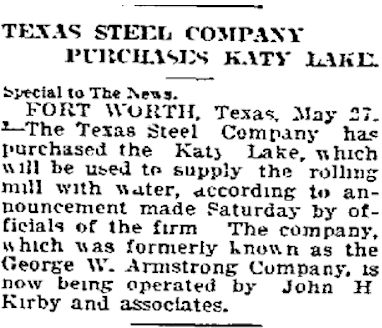 On May 8, 1923 the Dallas Morning News reported that nearby Texas Steel Company +(originally “Fort Worth Iron and Steel Company”) on Hemphill Street had bought Katy Lake.
On May 8, 1923 the Dallas Morning News reported that nearby Texas Steel Company +(originally “Fort Worth Iron and Steel Company”) on Hemphill Street had bought Katy Lake.
 In 1926 H. A. McCommas of Dallas bought the property and built Fort Worth’s fifth golf course around Katy Lake. The course had nine holes, five of them along the water. For the eighth hole golfers had to drive their tee shot over the lake to the green.
In 1926 H. A. McCommas of Dallas bought the property and built Fort Worth’s fifth golf course around Katy Lake. The course had nine holes, five of them along the water. For the eighth hole golfers had to drive their tee shot over the lake to the green.
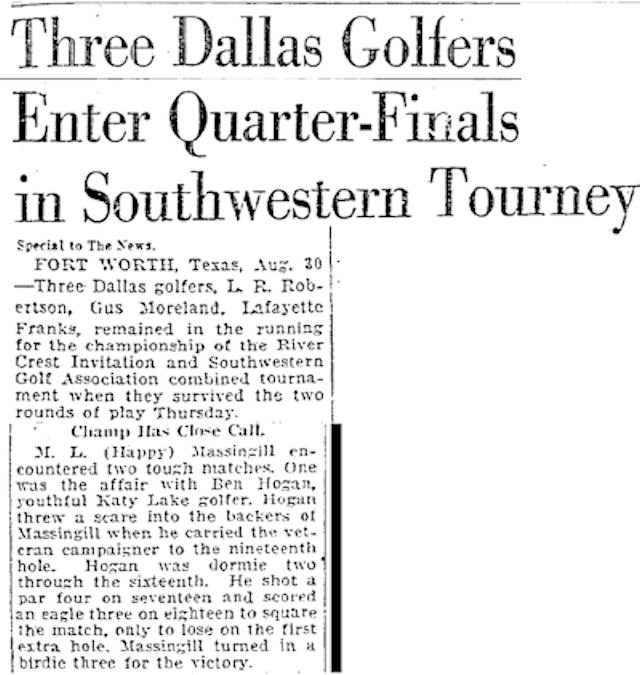 The Katy course may have been modest by today’s standards, but it would have its place in golf history. On August 31, 1928 the Dallas Morning News, in reporting on the River Crest Invitation and Southwestern Golf Association tournament, referred to “Ben Hogan, youthful Katy Lake golfer,” who was “dormie two” through the sixteenth hole.
The Katy course may have been modest by today’s standards, but it would have its place in golf history. On August 31, 1928 the Dallas Morning News, in reporting on the River Crest Invitation and Southwestern Golf Association tournament, referred to “Ben Hogan, youthful Katy Lake golfer,” who was “dormie two” through the sixteenth hole.
 In the 1930 census Hogan, then seventeen and living on East Allen Street, listed himself as “professor” at a golf course.
In the 1930 census Hogan, then seventeen and living on East Allen Street, listed himself as “professor” at a golf course.
 On July 14, 1953 Dallas Morning News columnist Paul Crume told another story of a youthful Ben Hogan at the Katy Lake course in the 1930s.
On July 14, 1953 Dallas Morning News columnist Paul Crume told another story of a youthful Ben Hogan at the Katy Lake course in the 1930s.
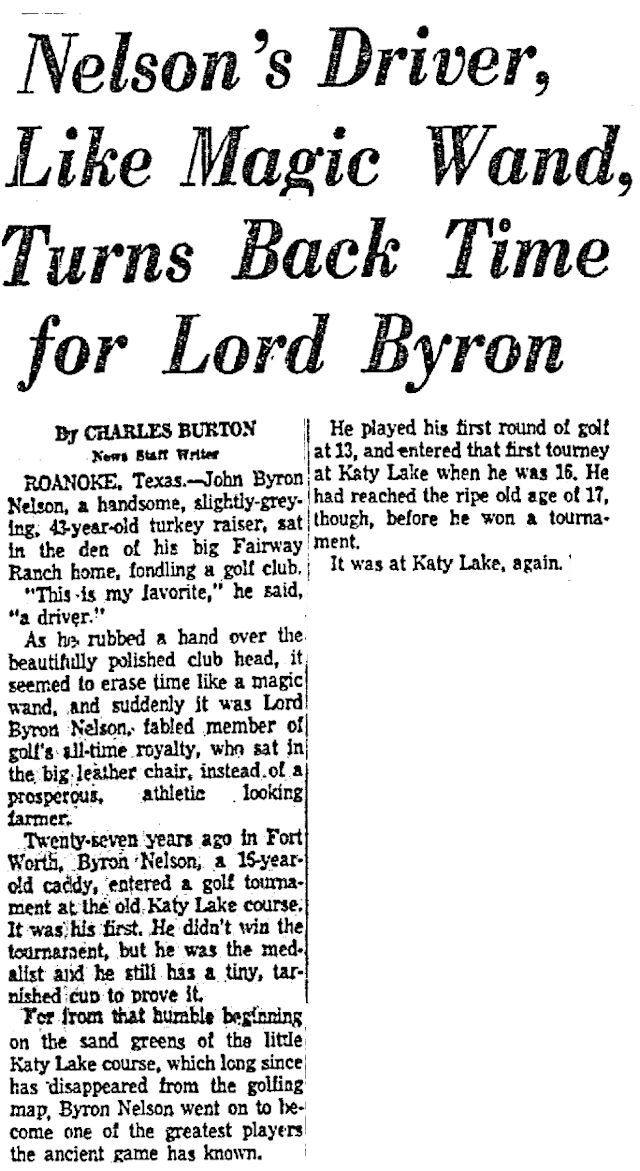 On Christmas Day 1955 another golf great looked back on his start at the Katy Lake course. Clip is from the Dallas Morning News.
On Christmas Day 1955 another golf great looked back on his start at the Katy Lake course. Clip is from the Dallas Morning News.
Writer Dan Jenkins also played Katy as a boy. In 2001 he told Golf Digest: “It was a public course only six blocks away. The greens weren’t really sand, I found out. They were dark brown cottonseed hull. Oiled so they wouldn’t blow away. There was an iron rake on every green—you raked your line from the ball to the cup before you putted.”
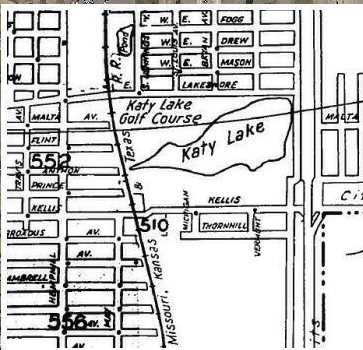 The city annexed the lake in 1949. A Sanborn map of 1949 shows the lake and golf course. You could play all day for fifty cents. Note “Thornhill” street south of the lake. We’ll come back to that.
The city annexed the lake in 1949. A Sanborn map of 1949 shows the lake and golf course. You could play all day for fifty cents. Note “Thornhill” street south of the lake. We’ll come back to that.
 There was a Katy Lake school on St. Louis Avenue north of the lake.
There was a Katy Lake school on St. Louis Avenue north of the lake.
 Early aerial photo of a sparsely settled South Side shows the lake in the upper-right corner. The grain elevator (1924) still stands on Alice Street. That’s Hemphill Street bisecting left to right. The side street with the jog in it is Butler Street. That factory on the right edge of Hemphill was Fort Worth Iron and Steel Company, which opened in 1905. Commonly called the “bolt factory,” it was located at the intersection of Hemphill and . . . wait for it . . . Bolt streets.
Early aerial photo of a sparsely settled South Side shows the lake in the upper-right corner. The grain elevator (1924) still stands on Alice Street. That’s Hemphill Street bisecting left to right. The side street with the jog in it is Butler Street. That factory on the right edge of Hemphill was Fort Worth Iron and Steel Company, which opened in 1905. Commonly called the “bolt factory,” it was located at the intersection of Hemphill and . . . wait for it . . . Bolt streets.
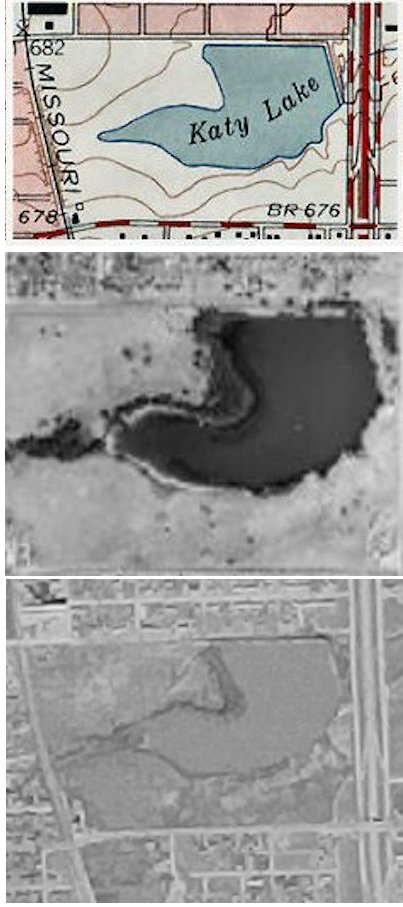
Photos show the dam along Bolt Street and Interstate 35 West. Water flowed in from the west.
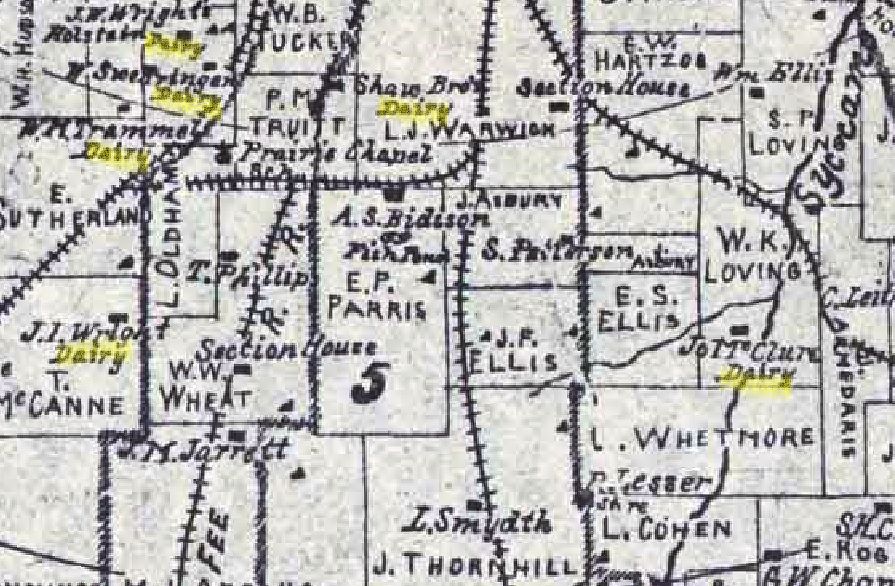
This detail of an 1895 map has much to tell us. For starters it shows Cowtown’s “little Wisconsin”: The area where Katy Lake would be impounded included at least six dairies, dominated by Shaw brothers where Our Lady of Victory is today. The McClure dairy, on the right, was in the fork of Sycamore Creek and a tributary. That tributary would be dammed to create Katy Lake. The tributary just to the north near the Houston & Texas Central track would be dammed in 1903 to create Echo Lake after the I&GN track was laid. Note the J. Thornhill survey south of where Katy Lake would be. Today South Main Street ends at Thornhill Street south of La Gran Plaza. This map detail foretells yet another lake. Just south of the Shaw dairy was the homestead of A. S. and Laura Biddison. Their “fish pond” south of today’s Biddison Street would become Silver Lake (see link at bottom of post). Biddison Street would still be the southern city limit in 1917. The railroad track running top to bottom in the center of the map was the Katy.
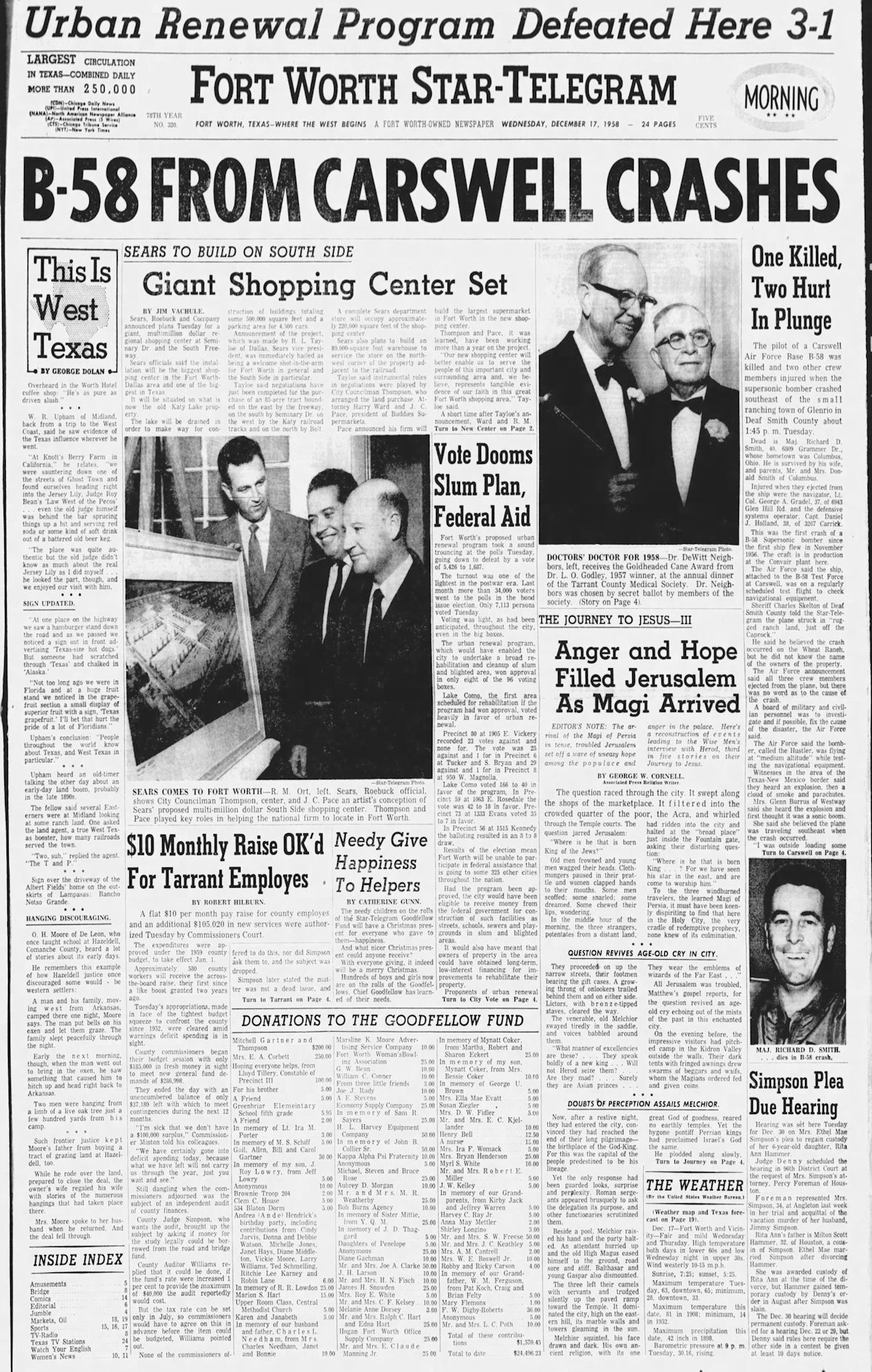 In December 1958 the Sears, Roebuck department store company announced plans to build Fort Worth’s first “regional shopping center” on the site of the lake. A Sears store would be the center’s anchor.
In December 1958 the Sears, Roebuck department store company announced plans to build Fort Worth’s first “regional shopping center” on the site of the lake. A Sears store would be the center’s anchor.
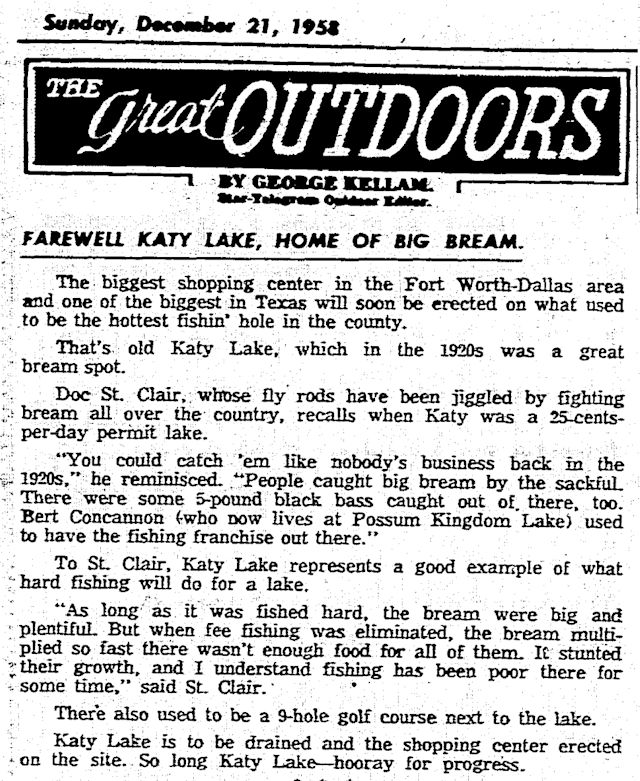 Star-Telegram outdoor editor George Kellam bid farewell to Katy Lake and its fish.
Star-Telegram outdoor editor George Kellam bid farewell to Katy Lake and its fish.
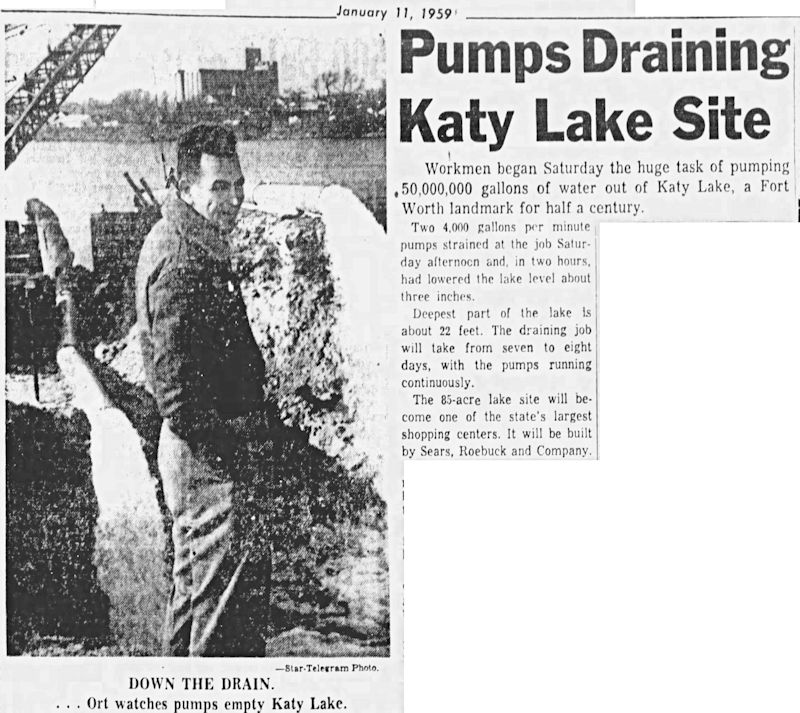 In 1959, after a life of a half-century, Katy Lake was drained. When you think about it, there must have been something very special about the Katy Lake property (location? price?) to cause the Sears people to look at it and think, “You know, if we just drained those fifty million gallons of water and then dug out eleven million cubic feet of dirt we’d have a dandy hole in which to build an eighty-five-acre shopping center.”
In 1959, after a life of a half-century, Katy Lake was drained. When you think about it, there must have been something very special about the Katy Lake property (location? price?) to cause the Sears people to look at it and think, “You know, if we just drained those fifty million gallons of water and then dug out eleven million cubic feet of dirt we’d have a dandy hole in which to build an eighty-five-acre shopping center.”
And so they did.
As the lake was drained of its fifty million gallons, catfish weighing thirty to forty pounds were revealed. Some found a new home at the James R. Record Aquarium at the zoo. Then enough dirt was removed to fill TCU’s Amon Carter Stadium four and one-half times.
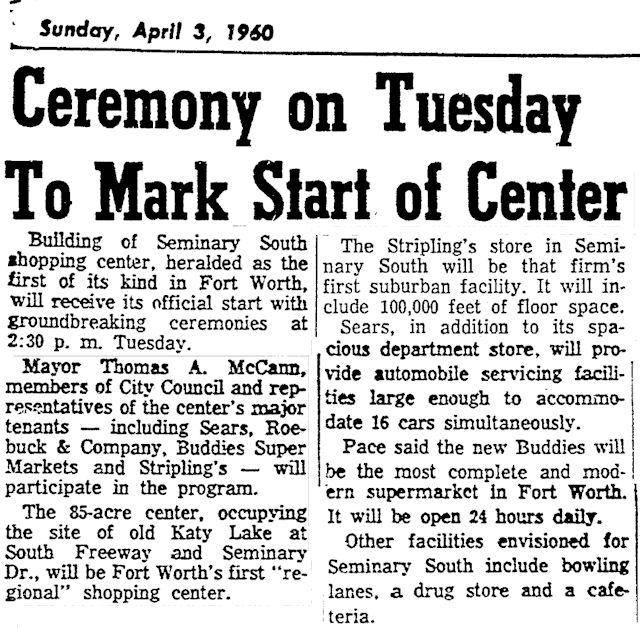 Then the construction began in 1960 with groundbreaking ceremonies on April 5. Other major stores in the mall would be Buddie’s and Stripling’s.
Then the construction began in 1960 with groundbreaking ceremonies on April 5. Other major stores in the mall would be Buddie’s and Stripling’s.
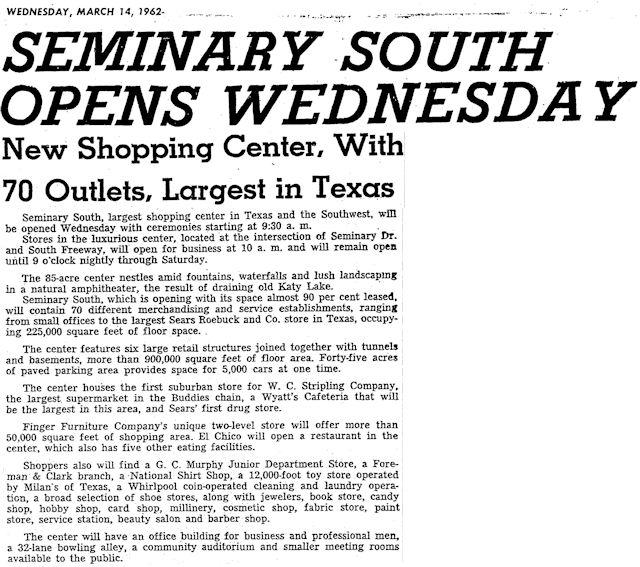 Seminary South opened on March 14, 1962. Some vital statistics of the finished product: 900,000 square feet of floor space walled in by two million bricks, forty-five acres of paved parking for five thousand cars, 160 million pounds of concrete, three hundred trees planted and watered by twelve miles of sprinkler system, 148,000 feet of plumbing pipe, 10,000 electrical outlets and 9,500 electrical fixtures connected by fifty-six miles of conduit and 210 miles of wiring.
Seminary South opened on March 14, 1962. Some vital statistics of the finished product: 900,000 square feet of floor space walled in by two million bricks, forty-five acres of paved parking for five thousand cars, 160 million pounds of concrete, three hundred trees planted and watered by twelve miles of sprinkler system, 148,000 feet of plumbing pipe, 10,000 electrical outlets and 9,500 electrical fixtures connected by fifty-six miles of conduit and 210 miles of wiring.
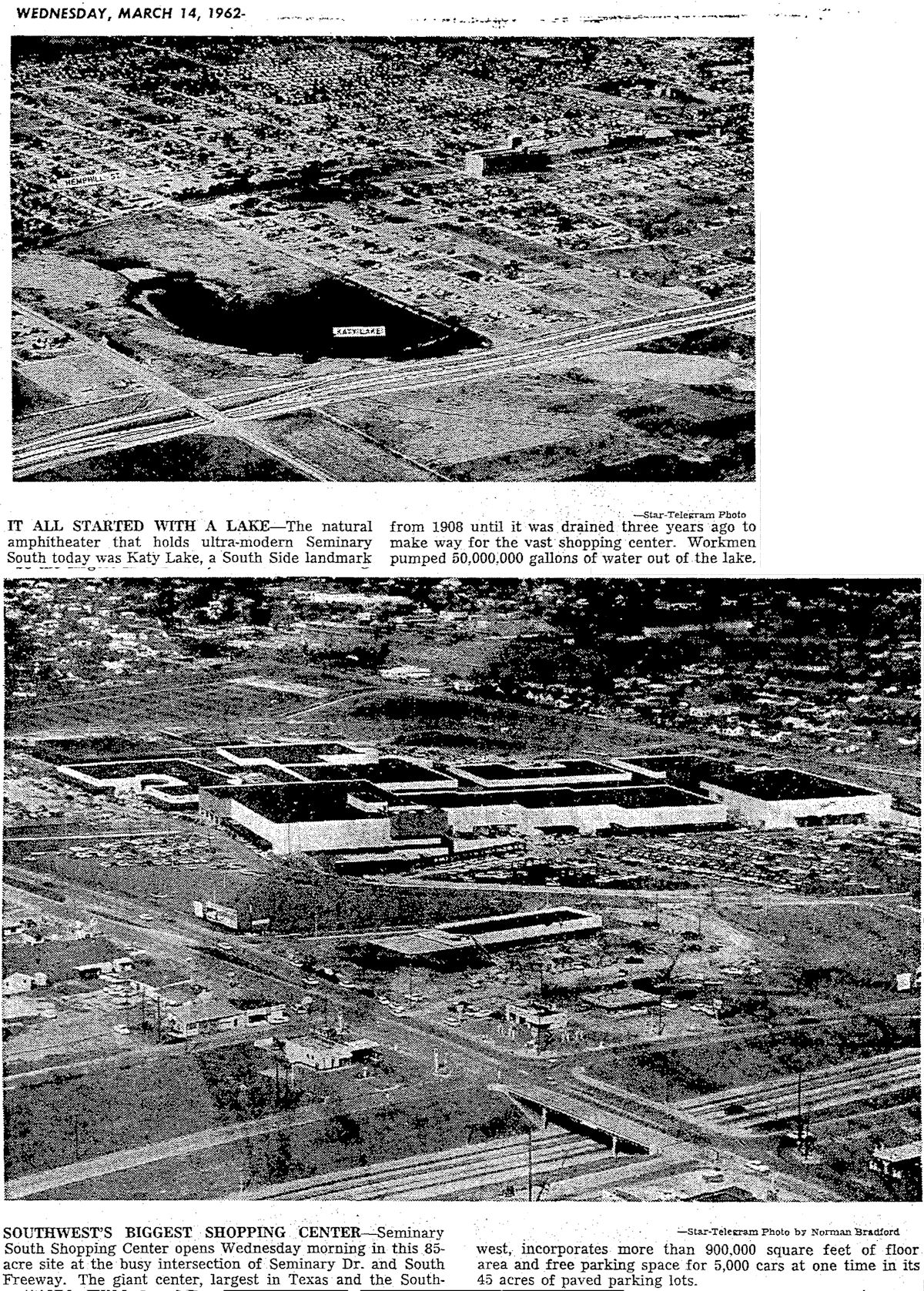 By the time Seminary South opened, three thousand workers had been involved in transforming a place to fish into a place to shop.
By the time Seminary South opened, three thousand workers had been involved in transforming a place to fish into a place to shop.
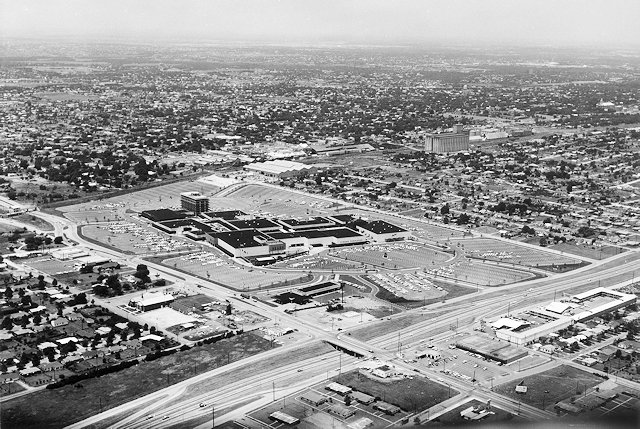
Seminary South about 1962. (Photo from Jack White Photograph Collection, University of Texas at Arlington Libraries.)
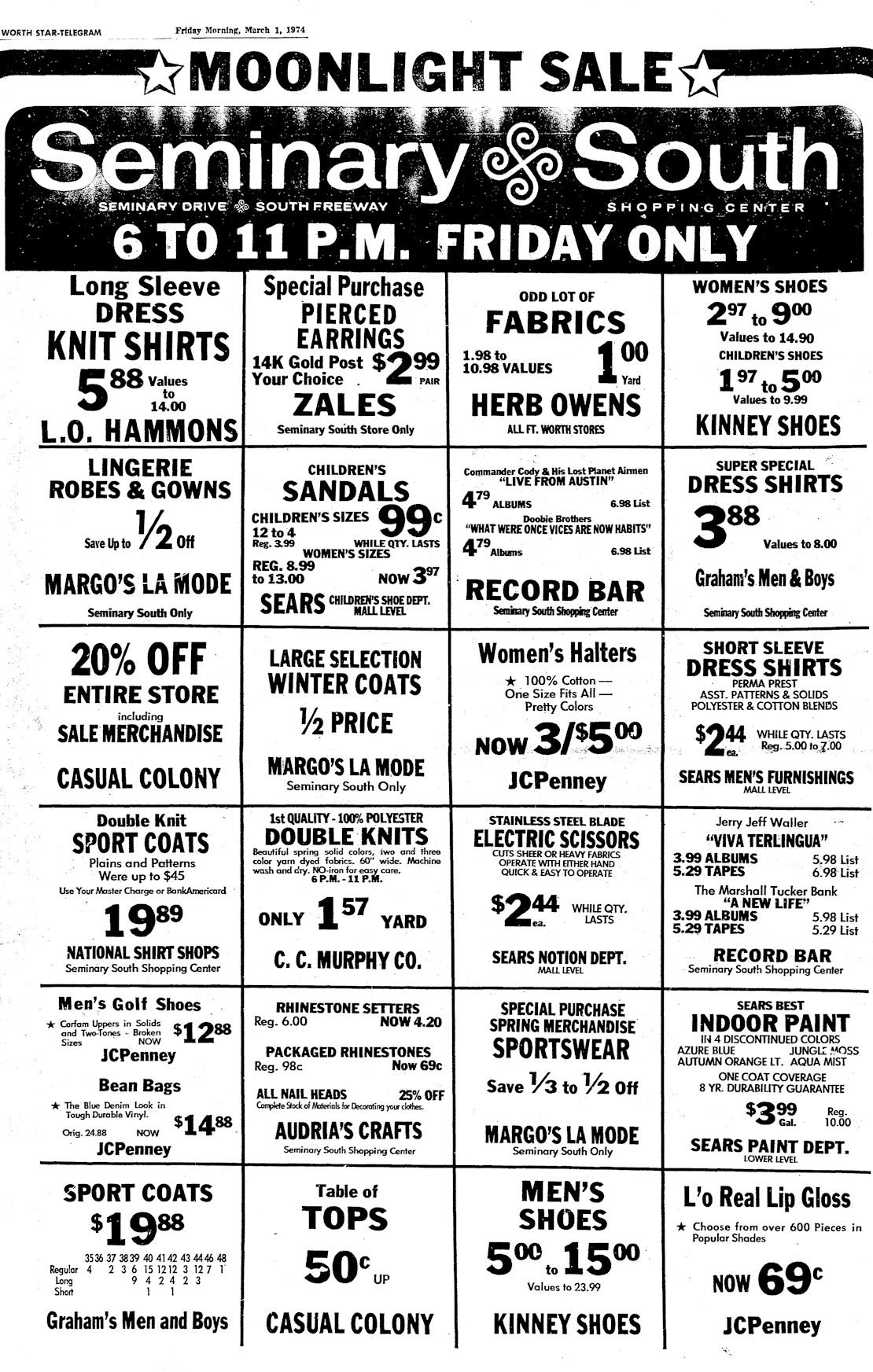
Remember these stores (and these prices)?
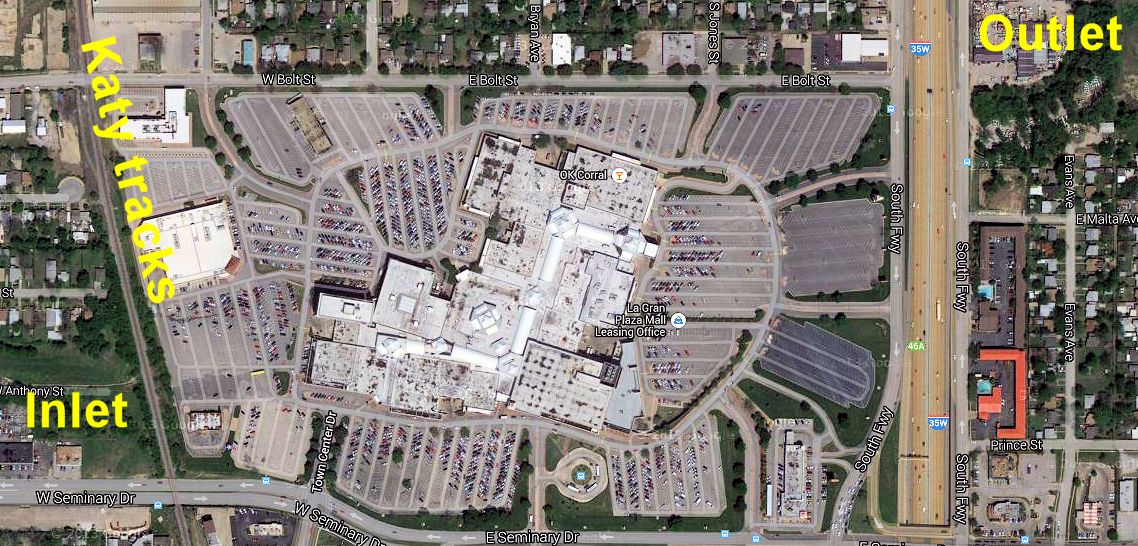 Yes, Katy Lake is dead and buried, its tombstone a shopping mall. The creek that fed Katy Lake also is gone. But the water that fed Katy Lake still flows in concrete storm-drain channels. However, now that water is diverted under the mall on the west at the Katy railroad tracks near Anthony Street. The water resurfaces east of the mall and I-35W near Malta Street and flows to Sycamore Creek.
Yes, Katy Lake is dead and buried, its tombstone a shopping mall. The creek that fed Katy Lake also is gone. But the water that fed Katy Lake still flows in concrete storm-drain channels. However, now that water is diverted under the mall on the west at the Katy railroad tracks near Anthony Street. The water resurfaces east of the mall and I-35W near Malta Street and flows to Sycamore Creek.
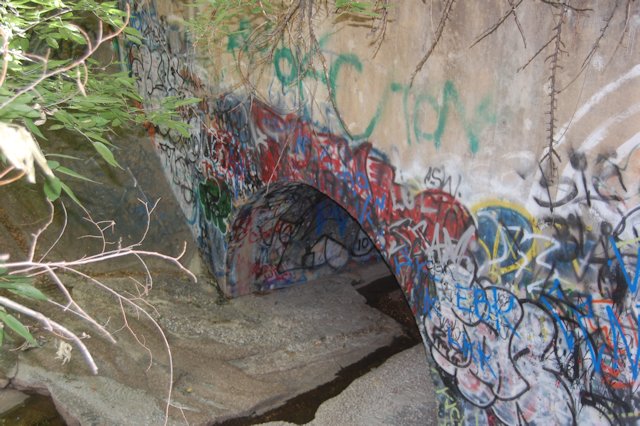 Just west of the mall on Anthony Street this tunnel takes storm-drain runoff under the mall to the east side of the interstate.
Just west of the mall on Anthony Street this tunnel takes storm-drain runoff under the mall to the east side of the interstate.
Want more lost lakes? Read about Tyler’s Lake and Elliot Lake on Riverside Drive, Tandy Lake on East Lancaster Avenue, Hust Lake on the East Side, Silver Lake on the South Side, Lake Togo on the North Side, and Lake Erie in Handley at From Katy to Tandy to Togo: The Lost Lakes of Cowtown.






I’m starting to feel old, but I was born the day Seminary South opened.
Who owned the property (Katy Lake) and surrounding acreage?
Who sold it to the investors? When and for how much?
Thank You
Katy railroad, Texas Steel Company, and H. A. McCommas were three of the owners over sixty years.
In reporting the sale in 1959, the Star-Telegram said H. G. Parr (president of Fort Worth Well and Machinery) sold 80 acres to Sears for “in excess of $300,000.”
In your research have you found any evidence of resistance to the filling in of Katy Lake and the building of Seminary South?
Good question but, no, I did not find any, but then I was not looking for that aspect. Am sure there was some NIMBY backlash.
I am looking for history of the Handley Masonic Lodge # 1140. We want to register it as a historical landmark. It celebrates its 100th year birthday this year. Any suggestions?
Mr. Wilder:
Maybe these will help.
Masonic Temple (817) 334-0331
Tarrant County Historical Commission
200 Taylor Street 5th Floor
Fort Worth TX 76196
Email: [email protected]
Texas Historical Commission
Great piece, Mike!
I can help with the “dormie 2” thing about Mr. Hogan. In that era, many competitions, including the PGA Championship, were staged using match play rather than stroke play, meaning that players were paired against each other in 18 hole matches in which each hole was a separate competition that one could win, lose, or halve. “Dormie 2” at #16 means that Mr. Hogan was 2 up with two holes to play — if he lost both, the match could be halved, but any other result would make him the winner. Most golfers who get to Dormie 2 go on to win the match.
Thanks for clearing that up, Chris.
thanks for all the work you do to get these articles together. They are so fascinating.
Thank you, Lori. Learning about my hometown has been more interesting than I thought it could ever be.
I was born and raised living on the Katy Lake property until 1958 I believe it was. I fished with my parents, Joe and Agatha Brown and my brother Clinton many times and my Daddy caught several fish as did my uncles and cousins. We had a great life there. When it was sold we moved to our new homw on South Jennings. Where I lived with my family until I married in 1968. Those were the ‘Good Ole Days’!
Lydia Sharon (Brown) Bidwell
I really enjoyed reading this! I was born in Fort Worth in 1957 and my parents bought their first and only home on Evans in 1958, right about the time they were draining Katy Lake. My parents always told me that there used to be a lake there but I didn’t remember seeing it. I watched I35 grow from a two lane highway to the way it is now. We could see Seminary South from our back door. Our street was a dead end into the bottom area that led to the creek. It was an area for local construction companies to dump unwanted materials. Those materials would become our playground as we built cities at least once from loads of broken asphalt. “Down the hill” gave us places for urban kids to pretend they lived in the country. Now that area is covered with golf cart storage. We had a vacant lot next door to us that my father mowed the entire time we lived there. Right before his death, the golf cart company bought land up to the top of the hill. We still own his house and the renter who lives there works for the golf cart company. It was a great little wilderness area to live at growing up in a city! Thanks for the memories, I was unaware of the history of the lake! What a thrill to learn that there was also a golf course, and how ironic to know there are golf carts right where the former lake empties now into the creek that leads to Sycamore Creek.
Thanks, JoAnn. I grew up along Sycamore Creek and remember when Katy Lake was drained but did not know Echo Lake even exists until I was grown. And was not aware of the two creeks from the lakes that flow into Sycamore Creek.
Katy Lake was our home for several years. I was born in Fort Worth and lived at the lake until I was 17 years old. Never imagined it would turn into a shopping center. I remember some good times growing up there!
There was a heavy snowfall the day the Mall opened.
My father Walter David Garland was one of the young golfers that played at the Katy Lake Golf Course. When I took up the game he told me he played regularly with Byron Nelson and Ben Hogan. In 1969 I was at the Colonial Invitational with a press pass. I was photographer for the NTSU student paper the Campus Chat and I saw walking up a cart path Byron Nelson. I said Mr. Nelson, my father Dave Garland, said he used to play golf with you at Katy Lake. He said “he most certainly did. That was a long time ago.” He asked what dad was doing and said to tell him hello.
Hometown:
Can the tunnels under this mall be reached from inside the mall? If you don’t know, who might? Thanks!
Per the photo, there is the mouth of a tunnel on the west side at the end of Anthony Street. I have not been in it.
Hello! I found this fascinating read about Ft. Worth on a link on facebook.
I belong to a group calling itself Vintage San Antonio and was wondering if I may please share the image of the MKT Railroad ad about San Antonio? I would attribute it to your blog or web page if you allow this.
I lived in the DFW area twice in the past twelve years and have spent a lot of time learing about it’s past. Thank you for your page.
Best regards!
Robert J. Casres
rjc
Thanks, Robert. Use anything you like. Wish I still had the high-resolution scan for you instead of just the 1200-wide reduction. Mike
This was a very interesting read and brought back many memories. I grew on the Southside as a child and remember going to Katy Lake to swim with friends and being run off by the security guard. When Katy Lake was dredged for the new Seminary South shopping center, we went to the tunnel and caught as many fish as we could. Later, as a young man, I went to work at Texas Steel in the early 1960’s until the plant shut down in the 1980’s (rolling mill). This was a great devastation to all who depended on Texas Steel for their livelihood. Most employees had no skills but working at the steel mill. That’s all they knew, so sad for most of the neighborhood!
thanks for the info
I have been looking for pictures of what the lake looked like before it got drained. All the information was great. I grew up in the area and still live here now. Things have definitely changed with the years. I wish we still lived in times when things seemed so much more simple.
Thanks, Erica. I, too, remember the lake and wish I could find more on it.
thanks for these pictures I grew up in this area and its nice to see some of the history.
You’re welcome. As a young boy more interested in critters than merchandise, I hated to see the lake become a mall.
I agree, I grew up around the area. Nice to see these pictures. Thanks!
Thanks, Diana. There aren’t many residential streets in Fort Worth that could write a book, but Samuels Avenue is one of them.